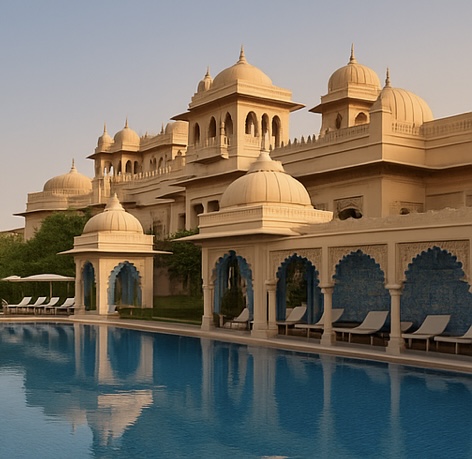“Luxury in India was never just worn – it was lived.” India’s luxury landscape extends far beyond fashion and accessories. From heritage hospitality to wellness rituals and artisanal craft, the country’s affluent consumers have long embraced a holistic interpretation of prestige that global brands are only beginning to understand.
As global luxury redefines itself around experiences, identity, and cultural depth, India presents a rare opportunity: a living civilization where luxury transcends categories. From the shimmer of handcrafted jewellery to the aroma of ancient attars, from opulent palaces that reimagine hospitality to holistic wellness rooted in Ayurveda, India’s luxury heritage is not confined to fashion – it is an ecosystem.
For decades, global luxury viewed India primarily as a sourcing destination or a rising consumer base. But today, the conversation is shifting. A new generation of creators, entrepreneurs, and heritage custodians is reimagining Indian luxury as a complete lifestyle expression – rooted in authenticity, powered by experience, and aligned with the global quest for meaning.
The Evolution from Product to Experience
In global luxury, the shift from ownership to experience has redefined value. Consumers no longer buy simply for possession – they buy for transformation. India embodies this evolution naturally.
A stay at a heritage palace-turned-hotel, such as Taj Rambagh or Umaid Bhawan, is not a transaction but a cultural immersion. A bottle of perfume from Forest Essentials is not just scent – it is philosophy distilled. A saree from Raw Mango, handwoven by Indian artisans, is both attire and identity.
These examples reveal India’s advantage: every touchpoint – craft, hospitality, cuisine, or wellness – can be an experience of luxury when reinterpreted through design, service, and storytelling.

Beyond Fashion: The Spectrum of Indian Luxury
To build a resilient luxury ecosystem, India must look beyond fashion and textiles. Several sectors are already demonstrating how heritage, innovation, and brand-building can merge:
Heritage Jewellery: Brands like Amrapali, Tanishq Zoya, and Sabyasachi Fine Jewellery are recontextualizing India’s regal ornamentation into contemporary, global design languages.
Luxury Hospitality: The Taj and Oberoi groups have turned India’s palaces and landscapes into immersive experiences of modern royalty, where service is an art form.
Home & Interior Design: Good Earth and Klove Studio exemplify how Indian craftsmanship and design sensibility can compete with Milan or Paris in aesthetic sophistication.
Perfumes & Wellness: The revival of attars and Ayurveda – through brands like Forest Essentials, Kama Ayurveda, and Naso Profumi – signals a new era of “mindful indulgence.”
Horology & Accessories: Emerging players like Bangalore Watch Company are proving that Indian-made precision can stand proudly on the world stage.
Each of these sectors adds another pillar to the architecture of a complete Indian luxury ecosystem – one that speaks not just of consumption, but of culture and consciousness.
From Brand to House: Building the Indian Maison
The next frontier for Indian luxury lies in institutionalization. While several homegrown brands have gained acclaim, few have evolved into Houses – entities that transcend product lines to represent a philosophy of excellence.
This transition requires what the West mastered through its “Maison” model: codified craftsmanship, narrative continuity, and cross-category presence. For Indian brands, this means expanding vertically – fashion evolving into home, beauty, and hospitality – and horizontally, by uniting artisans, designers, and cultural institutions under a single, coherent identity.
India’s future maisons must be built not just on aesthetics, but on purpose – sustainability, inclusivity, and local storytelling as core values.

The Strategic Roadmap: From Local to Global
For India to emerge as a global luxury powerhouse, three strategic levers must align:
Cultural Branding: Indian luxury needs a unified visual and verbal identity. Much like “Made in Italy” or “French savoir-faire,” India must define its own hallmark – perhaps anchored in the idea of “Mindful Opulence.”
Institutional Support: Policies that recognize luxury as an economic sector – tax incentives, export promotion for design brands, and investment in skill development – will strengthen the ecosystem.
Global Partnerships: Collaboration with global maisons, hospitality groups, and design councils can help Indian brands amplify their global credibility while maintaining authenticity.
When these forces converge, Indian luxury will no longer be perceived as a cultural curiosity, but as a contemporary force with global resonance.
India’s Moment of Integration
India’s luxury narrative is no longer about catching up – it’s about converging tradition with innovation. The same country that weaves the world’s finest textiles also leads digital transformation and wellness tourism. This intersection of heritage and technology offers India a singular advantage in crafting the next global luxury story – one that is multi-sensory, multi-sectoral, and unmistakably Indian.
The evolution from ateliers to ecosystems will define India’s luxury future. What began as craft will mature into culture; what was once local will become global.
Luxury in India was never just worn – it was lived. The world is finally ready to live it again.










